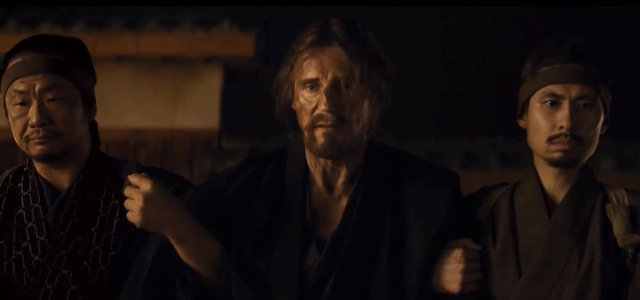
It’s tempting to write off any religious-themed picture from master filmmaker and ex-seminary student Martin Scorsese as an indulgence, a grasping attempt at cinematic atonement for a path not taken and a lifetime of making movie violence.
“Silence” does nothing to shake the feeling that the director of “The Last Temptation of Christ” and “Kundun” is wrestling with big ideas and never getting beneath the surface. A frustrating two hour and forty minute period piece about Jesuit priests having their faith tested and their lives threatened in 17th century Japan, it has maddeningly unsatisfying theological debates, scrupulous though myopic period detail and an utter lack of narrative drive.
It’s a quest tale with no payoff, a battle of wills with no victor with an ending that is more a cop-out than a climax. And the thoughts the viewer takes away from it cannot be what he or the novelist he’s adapting intended.
Andrew Garfield and Adam Driver are idealistic, impassioned Portuguese Jesuits who convince the head of their order (that high priest of gravitas, Ciaran Hinds) to send them to Japan, which has engaged in a murderous, decades-long persecution of priests and those they’ve converted to Christianity.
Inspired by a fierce priest (Liam Neeson) who preceded them, they want to find this missing man and clear his name. Reports indicate that Father Ferreira (Neeson) “apostatized,” renounced his faith to save his skin, and went native. Fathers Rodrigues and Garrpe refuse to believe this.
They’re smuggled into Japan by a troubled soul, Kichijiro (Yosuke Kabozuka). And on landing in an impoverished, wretched village, they learn there is a price on their heads and on the heads of the hidden Christians they encounter at every turn. As Father Rodrigues (Garfield) narrates, they stoically press on, impressed by the devotion of the locals, romantically linking their isolation, suffering and mission to that of early Christians hiding in the catacombs of Rome.
Persecution? They welcome it.
“The blood of martyrs is the seed of the Church.”
But as time drags on and they witness the faithful being sacrificed by ruthless authorities — murdered by fire, beheading or drowning — they come to question their work and the proper stance a Christian should take when presented with the choice of renouncing their faith, or dying.
And when Rodrigues faces the comically menacing old man called “The Inquisitor” (Issei Ogata) and his sneering interpreter (Tadanobu Asano), his nagging concern is that his prayers are being met with silence. But his worst fear is not getting his Great Theological Debate and of not winning it. The Inquisitor is content to torture Rodrigues’ flock and mock his “arrogance.”
“The price for your glory is THEIR suffering.”
The depiction of intrepid Jesuits facing death, unspeakable cruelty and myriad hardships reminded me of Roland Joffe’s heavy-handed “The Mission” (1986) and “Black Robe,” Bruce Beresford’s far more brisk and compelling 1991 film of Jesuits making contact with Native American tribes in 17th century Canada. “Silence” has the funereal pacing of TV’s “Shogun,” without the palace intrigues, sex and combat.
The only sparring here is verbal, the greatest mysteries are the inscrutability of Japanese intolerance and their version of Buddhism. If Christians are banned, why is Rodrigues allowed to minister to a flock in prison? If they’re Buddhists, how do they rationalize their many exotic tortures and forms of execution?
The story lacks the conventional ways this confrontation plays out. Rodrigues never makes the obvious argument — “If yours is the True Faith of Japan, then what do you have to fear from Christianity?”
Careful readers of Scorsese’s filmography will note that his most scripturally clumsy pictures are those he co-writes with his former-film-critic-turned-Yes-Man aide Jay Cocks (“Gangs of New York,””The Age of Innocence”). This undisciplined, meandering movie lacks structure, urgency and suspense.
Driver is no more convincing as a Jesuit than he was as a Jedi. But Garfield is positively beatific, and ably supported by a little-known and most capable Japanese cast. Asano stands out as a tormented drunk, saving his skin but unwilling to abandon his new faith, begging for Confession and forgiveness at each transgression.
Neeson is utterly wasted in a role that features prominently in the advertising and in the prologue and shrinks in the film’s anti-climactic climax.
 This is the third film based on Shusaku Endo’s most famous (1966) novel. I’m a sucker for period pieces, and you don’t write off the Great Scorsese’s work, even when he’s out of his element and aiming for the cerebral and celestial. But “Silence” smacks of an obligation, a passion project which he wouldn’t edit for clarity, in which the passion withered away long before the cameras rolled.
This is the third film based on Shusaku Endo’s most famous (1966) novel. I’m a sucker for period pieces, and you don’t write off the Great Scorsese’s work, even when he’s out of his element and aiming for the cerebral and celestial. But “Silence” smacks of an obligation, a passion project which he wouldn’t edit for clarity, in which the passion withered away long before the cameras rolled.

MPAA Rating:R for some disturbing violent content
Cast: Andrew Garfield, Liam Neeson, Tadanobu Asano, Issei Ogata, Yôsuke Kubozuka, Adam Driver, Ciaran Hinds
Credits:Directed by Martin Scorsese, script by Jay Cocks and Martin Scorsese, based on the Shûsaku Endô novel. A Paramount release.
Running time: 2:42
